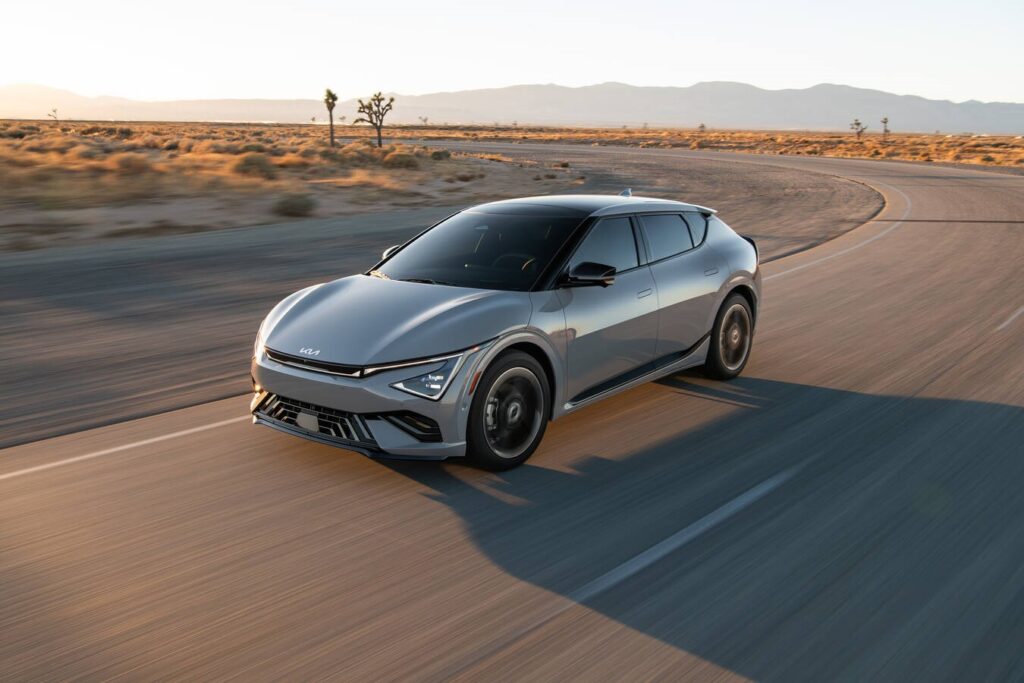38% of British Columbia’s greenhouse gas pollution is from transportation.
Many of us drive light duty vehicles that contribute significantly to local air pollution which in turn contributes to climate change.
But there is progress and you can join in to be part of the solution.
In 2023, 28% of new vehicles registered in BC were battery electric vehicles (BEVs) Many BC people are ready and making the switch. Surveys show that 94% of electric vehicle owners would never go back to gasoline or diesel cars. It’s fun! join us!
Not everyone can purchase an EV NOW. But you can plan that your NEXT car will be an EV.
You can start saving now and you can resist purchasing another gas car.
By voting with your wallet, you are saying to oil and gas and the (slow to adapt) auto industry that they won’t make money from you if they continue selling polluting products. You are opting out of that system that causes climate change. You are putting your money on the other side of the table for manufacturers who make compelling EVs that pollute far less than conventional ICE vehicles.
There are options for making your NEXT car an EV.
a used EV returned from a lease,
a short-range battery EV for use in the city,
a long-range battery EV suitable for long road trips,
a plug-in hybrid electric vehicle PHEV is right for you.
If it plugs into electricity to charge, it is an EV.
Drive Smarter & Save More.
Discover the Immediate Benefits of Electric Vehicles
Tired of high gas prices, noisy engines, and constant trips to the pump? Electric vehicles (EVs) offer a smarter, more rewarding way to drive. Here’s why switching to an EV could be the best decision you make this year:
Cost Savings
Cut your fuel costs by up to 75% and enjoy lower maintenance expenses.
Read more below…
Feel the Difference
Experience instant acceleration better handling with a lower center of gravity, less risk of a rollover and a peaceful, quiet ride.
Read more below…
Charge at Home
Wake up to a full battery every morning taking advantage of lower cost overnight electricity to charge while you sleep. Enjoy pre-heating/conditioning your car so it is warm (or cool) and ready to go when you are. No more lost time driving to gas stations, no more gas smell on your hands.
Clean Air
Reduce local air and water pollution in your community with zero tailpipe emissions
Read more below…
Get Rewarded
Apart from the respect and admiration of everyone around you who knows you are making the world a better place,
Take advantage of tax credits and incentives to lower your costs
Cost Savings
With an EV, you’ll spend less on fuel and maintenance. Here’s how
Electricity Beats Gas
Save up to $1,000 a year on fuel alone—electricity is cheaper and more stable than gas prices.
Plus you can take advantage of “time of day pricing to pay even less”.
(DYK gas vehicles lose 75% of their energy to heat? they are not energy efficient)
Less Maintenance
No oil changes. No transmission flushes.
Fewer brake pad changes because of regenerative braking.
Fewer moving parts.
Fewer parts in general make EVs more reliable with less chance of breakdowns. Maintenance costs drop by 50% or more.
Some EVs only need tires windshield washer fluid and (eventually) brakes.
Big Incentives
Many EVs qualify for federal and provincial incentives or tax breaks. And there are other incentive programs out there like Scrap-it
Fewer trips to the gas station
Not only can you avoid impulse purchases there, you can avoid driving the extra distance to get to the gas station and have the associated savings in fuel/energy / wear and tear on your vehicle
Lower total cost of ownership
The lifetime cost of an EV is now lower than that of a comparable gas powered vehicle including purchase price, fuel and maintenance.
Longer Expected Life
It is expected that most EVs will have the battery outlive the life of the car. Even with some normal degradation, electric motors are very resilient. Your EV should last and last and last, allowing you to pay it off and then not replace it. Skipping car replacement can save us $1,000s
Feel the Difference
EVs aren’t just practical—they’re a joy to drive. Fun, responsive, peppy.
Instant Power
Quick, smooth acceleration with electric torque, especially from zero to 30 where that power makes driving really fun.
While others are making their engines roar when the light turns green, you are already half way through the intersection.
Quiet Comfort
Near-silent operation for a peaceful ride. Suddenly you can hear and enjoy your music at a lower volume. Now you hear your tires and the wind on your windshield because you don’t have an annoying noisy engine.
Modern Tech
Advanced features like touchscreens and driver-assist systems come standard on most EVs.
With the most modern styling and features that anticipate your needs, sometimes it feels like you are piloting something from the future!
Regenerative Braking
Save your brakes. When you lift your foot off the accelerator the car start turning that forward motion back into power it stores in the battery. Driving downhill a long way? you are charging your battery? Stuck in stop and go traffic? you get back some of that power every time you stop.
It even allows you to use 1 pedal driving.
Better handling
It handles like its “on rails” because of its very low center of gravity. The battery is usually under the seats in the floor. This allows EVs to corner better and hug the road better than their gas counterparts.
Many EVs independently control the power going to each wheel allowing for better traction control in rain or snow than older technology gas and diesel vehicles.
Smooth Drives
EVs don’t need a transmission so there is always power and smooth acceleration unlike gas and diesel vehicles that have to keep shifting. Customizable driving modes let you easily shift from highly efficient to sporty handling and acceleration whenever you want.
Convenience
Charge While You Sleep and more!
Home Charging
95% of EV charging takes place at home. I can’t remember the last time I drove to a gas station. (Oh wait I can, when I rented a car on vacation)
Plug in at home and wake up to a full charge every morning
On-the-Go Options
Travelling long distances? Use conveniently located fast chargers that get you back on the road after you use the facilities and top up on snacks.
Below you can see a map showing some of the chargers in South Western BC
More Free Time
Instead of visiting the mechanic, the oil change place or the gas station. Spend your time going where you want.
Trip planning included
Many EV brands build charging stops into your route planning. On long trips, Tesla plans your charging for when the battery is low (10%) so you charge rapidly (~10 mins) back to 60% and get on the road again. Some brands also pre-heat the battery so it is at the optimal temperature to accept a fast charge.
Warm and defrosted in the winter
EVs that are plugged in can warm themselves and defrost the windows so the car is ready to go when you are. Scheduling options vary by model. Those same features let you start the AC to cool the vehicle before you get back to it on a hot sunny day
Dog Mode / Camp Mode
EVs can do more than gas cars. e.g. with Dog Mode, Camp Mode and Keep, several brands keep the cabin safe and comfortable while not driving in ways that support your lifestyle. Intelligent convenience.

Make Your Community Cleaner
Your choice makes a difference for yourself, your family, your neighbours and your community
Quit Fuming
Driving a battery Electric EV (BEV) means you stop creating local air pollution.
Zero emissions means zero emissions where you live. You and your neighbours breathe cleaner air and gain the health benefits.
With BC’s 97% renewable electricity you are driving fairly clean.
Stop Oil Spills
Your EV doesn’t need (or leak) oil like gas cars do. BEVs mean no more gross oil stains on your driveway or your road, which wash into the grass and waterways every time it rains. It means healthier streams and wildlife because unlike gas cars, BEVs don’t constantly leak oil
Lower Carbon Footprint
If you aren’t polluting while you drive, you aren’t contributing to climate change. Everyone knows that manufacturing a car creates carbon pollution. EVs pay off their carbon debt quickly, usually in the first year of ownership they get ahead of gas cars and every km driven after that is cleaner and less polluting than gas cars.
Inspire Others
If you can do it so can your neighbours. Be an example they can follow, showing them that convenient, fun cost effective transportation doesn’t need to pollute. Chat with folks, share what you learn. Invite them to also make your community cleaner.
Noise Pollution
Noise drowns out conversations, bothers wildlife and makes urban spaces more oppressive. Noise pollution isn’t discussed much, but driving an EV dramatically reduces noise levels (especially under 30km/h)
Cleaner Waterways
Tailpipe emissions from gas and diesel cars settle on the ground, on leaves, on buildings and get washed into waterways which threatens the health of aquatic life.
Less Lethal
Every year in Canada, people die from asphyxiation due to vehicles being left running in garages and carports. Reduce the risk for both intentional and unintentional asphyxiation /poisoning from vehicle exhaust. EVs are safe in this way.
Less cleaning
If you’ve cleaned your windows, or your patio furniture, or your blinds, you know there is lots of fine particulate in the air. diesel and gas vehicles produce many tonnes of this. Switching to an EV means you stop putting this junk in the air and taken together, we all end up producing less for you to clean up when you wipe down your patio furniture.
Cleaner Fuel Handling
By driving an EV, you stop contributing to the need for fuel trucks, tanker trains, bulk oil ships, pipelines, gas stations and all the other petroleum infrastructure that is leaking oil and gas into the ground and water and air. You stop encouraging all the activities that produce so much global pollution.
Installing EV Chargers at home
If you own your own home installing a charger is relatively easy. If you have a condo or are part of a strata it can be more complicated, but there are resources to help you. Learn about Charger levels, What is required and how to get started.
Learn about EV Charger Levels
Level 1 Plugs into a standard 120V plug, 1-2 Kilowatts. Charges 5-8 Km/hour. No need for an electrician, you might have a charger that was provided with your EV. Charger pricing starts at $150 CAD. Standard household outlet. Very slow; good only for overnight trickle charging or plug-in hybrids.
Level 2 Needs a 240V plug or wiring installed by an electrician. 3-19 Kilowatts. Charges 20-50 Km/hour. These are like the chargers at your public library, also called “quick chargers” :-). Electrician work is in the range of $750 Charger pricing starts at $200 CAD. Home charging (dedicated wall unit), workplaces, public AC stations. Main method for daily charging.
Level 3 25-350 Kilowatts. Charges 100-1000 Km/hour. These are the DC Fast chargers for highway fast charging, & road trips. Uses CHAdeMO, CCS, or NACS connectors. Not typically installed at home.
What comes first
1. Understand your charging options.
2. Purchase your EV.
3. Order your charger. (Tip: Amazon.ca has lots)
4. Use public charging while you wait for an electrician to install your charger plug/wiring at home.
5. Install your charger
6. Charge at home.
EV Charging Plugs
Listed in order of popularity/ compatibility. all plugs are considered safe and reliable.
Plug Name
Pros
Cons
NACS (2022)
“North American Charging Standard”
Smaller, lightweight plug is easier to handle
Natively supports Tesla vehicles
Access to Tesla Supercharger network
Growing industry adoption (starting 2025).
Other brands need adapters until 2025+.
International adoption uncertain
CCS (2011)
“Combined Charging Standard”
Widely adopted worldwide EU, AU, NA etc.
Most public fast-charging networks (Electrify Canada, Petro-Canada, Flo, etc.).
Good power levels (up to 350 kW on CCS2).
Very large plug.
Allows both CCS and J1772 charging in one plug.
Safe choice today, but long-term in North America, CCS may become a “legacy” standard.
Chademo (2009)
Was the Japanese charging standard adopted by Mitsubishi and Nissan etc.
Limited charger availability in North America
Slower and older “sunset” technology.
Very Large Plug
J1772 (2009)
Standard AC charging plug for most North American EVs
Reliable, widely available at home chargers and public Level 2 stations.
Inexpensive to install at home.
Not for fast charging—limited to AC charging (typically up to ~19 kW).
Being replaced by NACS for new EVs.
Strata Information
VEVA the Vancouver Electric Vehicle Association has information for condos Link
VEVA Overview Presentation Link
EV Ready Checklist Link
Plug-in BC offers an Advisor service for stratas. Link
BCHydro information on rebates for strata charging Link
Strata or complex owners installing EV Ready infrastructure can receive up to 50% of the cost for infrastructure and installation. This rebate is available to a maximum of $600 per parking stall, and a project maximum of $120,000, while funding lasts. Select municipalities offer top-ups that increase rebate amounts.

